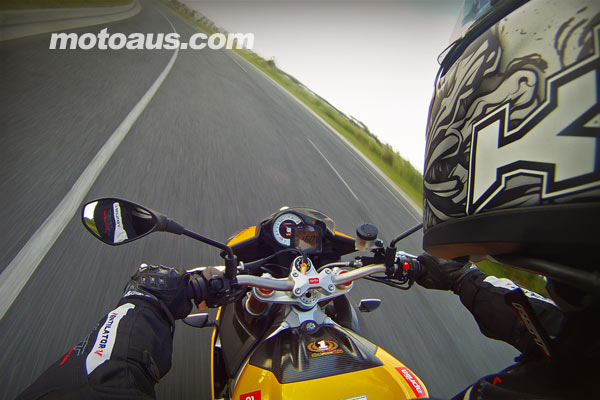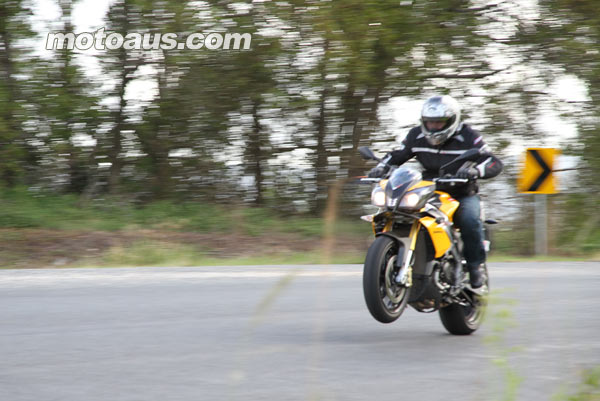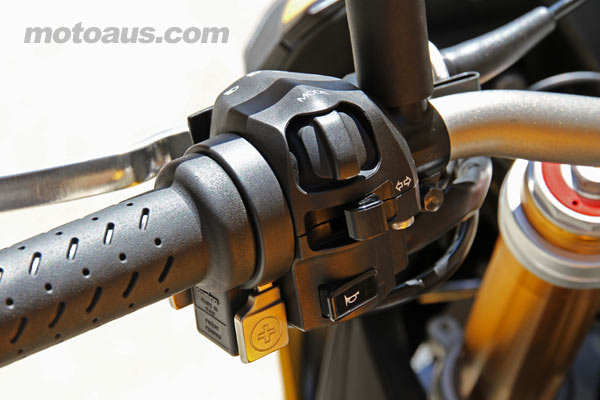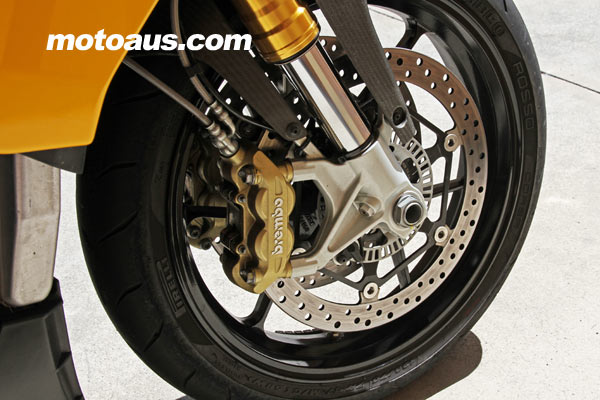
We ride the V4 version of the ultimate naked, the Aprilia Tuono V4R APRC.

Aprilia Tuono V4R APRC Review
Back in 2002 Aprilia created a surprise hit with a bike that has thrilled all who have had the pleasure of owning, or at the very least, riding.
The Tuono was essentially a sportsbike with the fairing removed, and a set of high bars and a confronting nose cone bolted on. Sounds simple, the result was complex. A whole new class of bike was created, a naked bike that went, stopped and handled about as well as its bigger superbike brother, with a whole extra serving of fun thrown in.
The wide bars made it easier to throw around in slower corners, the upright riding position a natural for power wheelies. Licences were suspended as fast as riders could buy the Tuono. This was a bike that urged you to twist the throttle. It was that good, we still rank the 2007 2nd Generation Tuono as perhaps the most fun ride of all of the hundreds of bikes we have ridden or tested.

So from the moment the RSV4 was announced, the idea of a V4 powered Tuono was forefront in the minds of a lot of naked bike fans. Naked versions of sportsbikes tend follow to a similar theme – remove the plastics and some horsepower, and soften it up.
The Aprilia RSV4 Tuono is a bit different. Not much plastic is missing,the power doesnt feel like it’s missing, and the handling is far from soft. Aprilia did delve in a little, a camshaft degree change here, a flywheel weight there. Some gear ratios are changed.
But, like the first thunderous Tuono, the RSV4 version retains almost all of the howling top end rush of the superbike, along with the full complement of Aprilia’s latest electronic finery, the “APRC” ( Aprilia Performance Ride Control) package which can limit or enhance such things as wheelies and tyre smoking corner exits.
Handling is right up there too, as is the discomfort level. That’s right, apart from the higher, wider bars which make steering the beast easier, the firm suspension, razor sharp steering, and race-hard seat are all there. And what a package this creates. The noise of the V4 is so good it should only be available on prescription, running it up through the gears – clutch less- with the quick shifter and some throttle wound on is one of motorcycling’s finest experiences.

Our test was conducted almost all on public roads, so any discussion about the V4R’s 165 odd horsepower is academic; it is simply way more than enough. The Brembo brakes can drive your arms back through your puny shoulders, and it simply handles way better than anyone I know can ride on the road.
For fans of the older twin cylinder Tuono, don’t expect the same bike with an extra 2 cylinders. The RSV4 version is smaller, much faster, and more focused on getting you around a track. 40 more horsepower and ten kilos less is a serious upgrade. Even the riding position – upright bars and all – has you in a slight forward crouch.
The only way you will be able to really run this Thunder up to its limits will be at a track day. That’s not to say it isn’t a decent road bike, compared to the supersport 1000’s, it is certainly more user friendly. But don’t expect to be shaking off one of these with your R1 for example; the Tuono will be right there poking its insect-like face in your mirrors.

Delving into the reasons behind the Tuono’s character, the changes in detail from the RSV4:
Intake tracts are lengthened by 20mm, and the cam timing is changed. This brings the peak power and torque a little bit lower in the rev range, with a lower 11,500 redline.
A slightly heavier flywheel and lower ratios in the first three gears put it to the ground nicely.
Chassis wise, the engine is slightly lower, and the trail figure is increased, making the Tuono a little more stable. Of course the mapping in the ECU with its 3 modes is Tuono specific.
Ride by wire throttle, and then traction and wheelie control, all with adjustable levels allow a setup from mild to wild.

Given our enthusiasm for drag racing, we were eager to try out the electronic launch control. Whilst you can trick it into a stumble or even a short sharp wheelie, a couple of goes and you can have the Tuono resembling a missile launch. Wind on full throttle and let the software do its work. The front tyre skims the road, er.. I mean track.. and you simply keep it pinned and clutchlessly upshift. Large numbers appear on the speedo very quickly.
What this description is missing is a soundtrack; the Tuono simply has to be ridden to be appreciated. The exhaust is reportedly a few kilos lighter than the RSV4 fitment, and is surprisingly loud when hard on the throttle. We loved it.
Price wise, at over 23 thousand the Tuono isn’t cheap, but you get a pretty big list of techno-trickery and quality components.

Is the Tuono for everyone? No. The Tuono may suit you if you are looking for one step back from a litre supersport bike, or as a step up from your softy naked UJM. Owners of the V-Twin Tuono would need to ride the V4 first before you switched, it is a very different bike. Pillions are catered for, the rear seat area is nicer than a supersport 1000, but won’t get your missus over the Nullabor. The fuel range is more suited to pleasure riding rather than touring distances.
None of those things matter after you ride it, the Tuono is a simply stunning motorcycle.
I dare you to ride it and say different.
Ups:
The Sound
The Electronic package is state of the art.
Exotic and different.
Downs:
A bit spendy
BYO self control
Scroll down page for full size image gallery and specifications




Click on any small image below to open full size gallery
{gallery}aprilia/tuono-v4/R-APRC/pictures{/gallery}
Aprilia Tuono V4R Specifications
Compression ratio: 13:1
Maximum power at the crank: 167.3 CV (123 kW) @ 11.500 rpm
Maximum torque at the crank: 111.5 Nm @ 9.500 rpm
Fuel system: Airbox with front dynamic air intakes. 4 Weber-Marelli 48-mm throttle bodies with 4 injectors and latest generation Ride-by-Wire engine management. Choice of three different engine maps selectable by the rider with bike in motion: T (Track), S (Sport), R (Road)
Ignition: Magneti Marelli digital electronic ignition system integrated in engine control system, with one spark plug per cylinder and “stick-coil” type coils
Starting: Electric
Exhaust: 4 into 2 into 1 layout, single oxygen sensor, lateral single silencer with ECU-controlled bypass valve and integrated trivalent catalytic converter (Euro 3)
Generator: Flywheel mounted 420W alternator with rare earth magnets
Lubrication: Wet sump lubrication system with oil radiator and two oil pumps (lubrication and cooling)
Gear box: 6-speed cassette type gearbox
1st: 39/15 (2,600)
2nd: 33/16 (2.063)
3rd: 34/20 (1,700)
4th: 32/22 (1,455)
5th: 34/26 (1,308)
6th: 33/27 (1,222)
Aprilia Quick Shift electronic system (AQS) on APRC version
Clutch: Multiplate wet clutch with mechanical slipper system
Primary drive: Straight cut gears and integrated flexible coupling, drive ratio: 73/44
Final drive: Chain: Drive ratio: 42/16
Frame: Aluminium dual beam chassis with cast and pressed sheet elements.
Front suspension: 43mm Sachs upside down forks. Adjustable preload, compression and rebound damping.
Wheel travel: 120 mm
Rear suspension: Sachs piggy back monoshock with adjustable preload, compression and rebound damping.
APS progressive linkage. Wheel travel: 130 mm
Brakes:
Front: Dual 320 mm floating stainless steel discs. Brembo radial callipers with 4 opposed 32 mm pistons.
Axial pump master cylinder and metal braided brake hoses.
Rear: 220-mm diameter disc; Brembo floating calliper with two isolated pistons. Metal braided hose.
Wheels: Cast aluminium. Front.:3.5″X17″ Rear:6.00″X17″
Tyres:
Radial tubeless. Front: 120/70 ZR 17
Rear: 190/55 ZR 17
Dimensions:
Max. length: 2065 mm Max. width: 800 mm (at the handlebar)
Max. height: 1090 mm Min. height from the ground: 125 mm
Seat height: 835 mm Wheelbase: 1445 mm
Trail: 107.5 mm Steering angle:25°
Dry weight: 183 kg
Fuel Capacity: 17 litres

